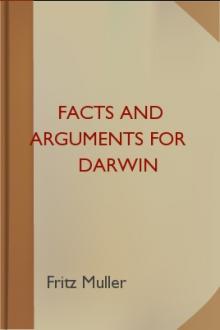Facts and Arguments for Darwin by Fritz Muller (read along books .TXT) 📕

- Author: Fritz Muller
- Performer: -
Book online «Facts and Arguments for Darwin by Fritz Muller (read along books .TXT) 📕». Author Fritz Muller
(* I will here briefly give my reasons for the opinion that the so-called “complete metamorphosis” of Insects, in which these animals quit the egg as grubs or caterpillars, and afterwards become quiescent pupae incapable of feeding, was not inherited from the primitive ancestor of all Insects, but acquired at a later period.
The order Orthoptera, including the Pseudoneuroptera (Ephemera, Libellula, etc.) appears to approach nearest to the primitive form of Insects. In favour of this view we have:—
1. The structure of their buccal organs, especially the formation of the labium, “which retains, either perfectly or approximately, the original form of a second pair of maxillae” (Gerstacker).
2. The segmentation of the abdomen; “like the labium, the abdomen also very generally retains its original segmentation, which is shown in the development of eleven segments” (Gerstacker). The Orthoptera with eleven segments in the abdomen, agree perfectly in the number of their body-segments with the Prawn-larva represented in Figure 33, or indeed, with the higher Crustacea (Podophthalma and Edriophthalma) in general, in which the historically youngest last thoracic segment (see page 123), which is sometimes late-developed, or destitute of appendages, or even deficient, is still wanting.
3. That, as in the Crustacea, the sexual orifice and anus are placed upon different segments; “whilst the former is situated in the ninth segment, the latter occurs in the eleventh” (Gerstacker).
4. Their palaeontological occurrence; “in a fossil state the Orthoptera make their appearance the earliest of all Insects, namely as early as the Carboniferous formation, in which they exceed all others in number” (Gerstacker).
5. The absence of uniformity of habit at the present day in an order so small when compared with the Coleoptera, Hymenoptera, etc. For this also is usually a phenomenon characteristic of very ancient groups of forms which have already overstepped the climax of their development, and is explicable by extinction in mass. A Beetle or a Butterfly is to be recognised as such at the first glance, but only a thorough investigation can demonstrate the mutual relationships of Termes, Blatta, Mantis, Forficula, Ephemera, Libellula, etc. I may refer to a corresponding remarkable example from the vegetable world: amongst Ferns the genera Aneimia, Schizaea and Lygodium, belonging to the group Schizaeaceae which is very poor in species, differ much more from each other than any two forms of the group Polypodiaceae which numbers its thousands of species.
If, from all this, it seems right to regard the Orthoptera as the order of Insects approaching most nearly to the common primitive form, we must also expect that their mode of development will agree better with that of the primitive form, than, for example, that of the Lepidoptera, in the same way that some of the Prawns (Peneus) approaching most closely the primitive form of the Decapoda, have most truly preserved their original mode of development. Now, the majority of the Orthoptera quit the egg in a form which is distinguished from that of the adult Insect almost solely by the want of wings; these larvae then soon acquire rudiments of wings, which appear more strongly developed after every moult. Even this perfectly gradual transition from the youngest larva to the sexually mature Insect, preserves in a far higher degree the picture of an original mode of development, than does the so-called complete metamorphosis of the Coleoptera, Lepidoptera, or Diptera, with its abruptly separated larva-, pupa-and imago-states.
The most ancient Insects would probably have most resembled these wingless larvae of the existing Orthoptera. The circumstance that there are still numerous wingless species among the Orthoptera, and that some of these (Blattidae) are so like certain Crustacea (Isopods) in habit that both are indicated by the same name (“Baratta”) by the people in this country, can scarcely be regarded as of any importance.
The contrary supposition that the oldest Insects possessed a “complete metamorphosis,” and that the “incomplete metamorphosis” of the Orthoptera and Hemiptera is only of later origin, is met by serious difficulties. If all the classes of Arthropoda (Crustacea, Insecta, Myriopoda and Arachnida) are indeed all branches of a common stem (and of this there can scarcely be a doubt), it is evident that the water-inhabiting and water-breathing Crustacea must be regarded as the original stem from which the other terrestrial classes, with their tracheal respiration, have branched off. But nowhere among the Crustacea is there a mode of development comparable to the “complete metamorphosis” of the Insecta, nowhere among the young or adult Crustacea are there forms which might resemble the maggots of the Diptera or Hymenoptera, the larvae of the Coleoptera, or the caterpillars of the Lepidoptera, still less any bearing even a distant resemblance to the quiescent pupae of these animals. The pupae, indeed, cannot at all be regarded as members of an original developmental series, the individual stages of which represent permanent ancestral states, for an animal like the mouthless and footless pupa of the Silkworm, enclosed by a thick cocoon, can never have formed the final, sexually mature state of an Arthropod.
In the development of the Insecta we never see new segments added to those already present in the youngest larvae, but we do see segments which were distinct in the larva afterwards become fused together or disappear. Considering the parallelism which prevails throughout organic nature between palaeontological and embryonic development, it is therefore improbable that the oldest Insects should have possessed fewer segments than some of their descendants. But the larva of the Coleoptera, Lepidoptera, etc., never have more than nine abdominal segments, it is therefore not probable that they represent the original young form of the oldest Insects, and that the Orthoptera, with an abdomen of eleven segments, should have been subsequently developed from them.
Taking into consideration on the one hand these difficulties, and on the other the arguments which indicate the Orthoptera as the order most nearly approaching the primitive form, it is my opinion that the “incomplete metamorphosis” of the Orthoptera is the primitive one, INHERITED from the original parents of all Insects, and the “complete metamorphosis” of the Coleoptera, Diptera, etc., a subsequently ACQUIRED one.)
Which of the different modes of development at present occurring in a class of animals may claim to be that approaching most nearly to the original one, is easy to judge from the above statements.
The primitive history of a species will be preserved in its developmental history the more perfectly, the longer the series of young states through which it passes by uniform steps; and the more truly, the less the mode of life of the young departs from that of the adults, and the less the peculiarities of the individual young states can be conceived as transferred back from later ones in previous periods of life, or as independently acquired.
Let us apply this to the Crustacea.
CHAPTER 12. PROGRESS OF EVOLUTION IN CRUSTACEA.
According to all the characters established in the last paragraph, the Prawn that we traced from the Nauplius through states analogous to Zoea and Mysis to the form of a Macrurous Crustacean appears at present to be the animal, which in the section of the higher Crustacea (Malacostraca) furnishes the truest and most complete indications of its primitive history. That it is the most complete is at once evident. That it is the truest must be assumed, in the first place, because the mode of life of the various ages is less different than in the majority of the other Podophthalma; for from the Nauplius to the young Prawn they were found swimming freely in the sea, whilst Crabs, Porcellanae, the Tatuira, Squilla, and many Macrura, when adult usually reside under stones, in the clefts of rocks, holes in the earth, subterranean galleries, sand, etc., not to mention other deviations in habits such as are presented by the Hermit Crabs, Pinnotheres, etc.,—and secondly and especially because the peculiarities which distinguish the Zoea of this species particularly from other Zoeae (the employment of the anterior limbs for swimming, the furcate tail, the simple heart, the deficiency of the paired eyes and abdomen at first, etc.) are neither to be deduced from a retro-transfer of late-acquired advantages to this early period of life, nor to be regarded at all as advantages over other Zoeae which the larva might have acquired in the struggle for existence.
A similar development must have been once passed through by the primitive ancestor of all Malacostraca, probably differing from that of our Prawn, especially in the circumstance that it would go on more uniformly without the sudden change of form and mode of locomotion produced in the latter by the simultaneous sprouting forth and entering into action in the Nauplius of four and in the Zoea of five pairs of limbs. It is to be supposed that, not only originally but even still, in the larvae of the first Malacostraca, the new body-segments and pairs of limbs are formed singly,—first of all the segments of the fore-body, then those of the abdomen, and finally those of the middle-body,—and, moreover, that in each region of the body the anterior segments were formed earlier than the posterior ones, and therefore last of all the hindermost segment of the middle-body. Of this original mode more or less distinct traces still remain, even in species in which, in other respects, the course of development of their ancestors is already nearly effaced. Thus the abdominal feet of the Prawn-larva represented in Figure 33, are formed singly from before backwards, and after these the last feet of the middle-body; thus, in Palinurus, the last two pairs of feet of the middle-body are formed later than the rest; thus in the young larvae of the Stomapoda the last three abdominal segments are destitute of limbs, which are still wanting on the last of them in older larvae; and thus, in the Isopoda, the historically newest pair of feet is produced later than all the rest. In the Copepoda this formation of new segments and limbs, gradually advancing from before backwards, is more perfectly preserved than in any of the higher Crustacea. ( It is well known that, in many cases, even in adult animals the last segment of the middle-body, or some of its last segments, either want their limbs or are themselves deficient (Entoniscus Porcellanae male, Leucifer, etc.). This might be due to the animals having separated from the common stem before these limbs were formed at all. But in those cases with which I am best acquainted, it seems to me more probable that the limbs have been subsequently lost again. That these particular limbs and segments are more easily lost than others is explained by the circumstance that, as the youngest, they have been less firmly fixed by long-continued inheritance. (“Mr. Dana believes, that in ordinary Crustaceans, the abortion of the segments with their appendages almost always takes place at the posterior end of the cephalothorax.”—Darwin, Balanidae, page 111.))
The original development of the Malacostraca starting from the Nauplius, or the lowest free-living grade with which we are acquainted in the class of Crustacea, is now-a-days nearly effaced in the majority of them. That this extinction has actually taken place in the way already deduced as a direct consequence from Darwin’s theory, will be the more easily demonstrated, the more this process is still included in the course of life, and the less completely it is already worn out. We may hope to obtain the most striking examples in the still unknown developmental history of the various Schizopoda, Peneidae, and, indeed, of the Macrura in general. At present the multifarious Zoea-forms appear to be particularly instructive. Almost all the peculiarities by which they depart from the primitive





Comments (0)